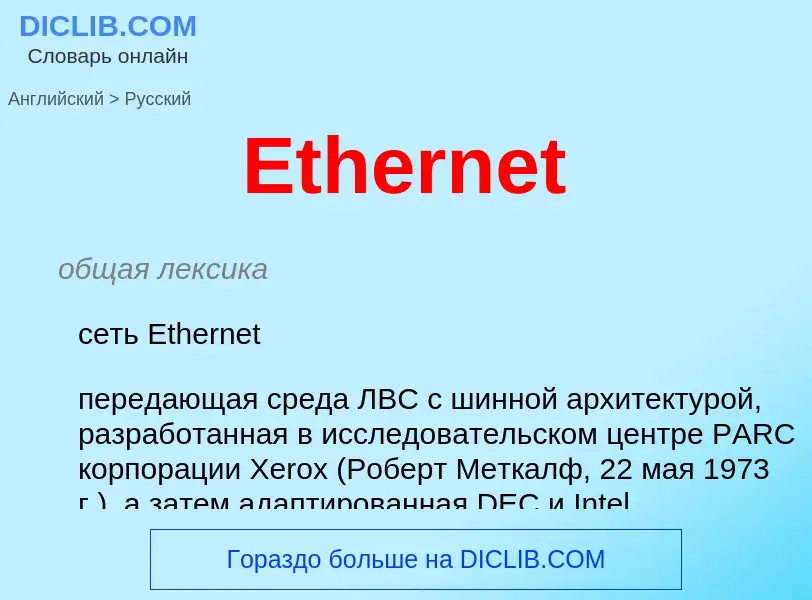Vertaling en analyse van woorden door kunstmatige intelligentie ChatGPT
Op deze pagina kunt u een gedetailleerde analyse krijgen van een woord of zin, geproduceerd met behulp van de beste kunstmatige intelligentietechnologie tot nu toe:
- hoe het woord wordt gebruikt
- gebruiksfrequentie
- het wordt vaker gebruikt in mondelinge of schriftelijke toespraken
- opties voor woordvertaling
- Gebruiksvoorbeelden (meerdere zinnen met vertaling)
- etymologie
Ethernet - vertaling naar Engels
общая лексика
сеть Ethernet
передающая среда ЛВС с шинной архитектурой, разработанная в исследовательском центре PARC корпорации Xerox (Роберт Меткалф, 22 мая 1973 г.), а затем адаптированная DEC и Intel. Регламентируется стандартами IEEE 802.3 и ISO 8802.3. Регламентирует в качестве передающей среды коаксиальный кабель, метод управления доступом CSMA/CD, скорость передачи данных 10 Мбит/с, размер пакета от 72 до 1526 байтов, а также метод кодирования данных. В одной сети Ethernet может работать до 1024 рабочих станций. Развитие этой технологии для сетей 100 Мбит/с - Fast Ethernet
Смотрите также
Definitie
Wikipedia

Ethernet () is a family of wired computer networking technologies commonly used in local area networks (LAN), metropolitan area networks (MAN) and wide area networks (WAN). It was commercially introduced in 1980 and first standardized in 1983 as IEEE 802.3. Ethernet has since been refined to support higher bit rates, a greater number of nodes, and longer link distances, but retains much backward compatibility. Over time, Ethernet has largely replaced competing wired LAN technologies such as Token Ring, FDDI and ARCNET.
The original 10BASE5 Ethernet uses a thick coaxial cable as a shared medium. This was largely superseded by 10BASE2, which used a thinner and more flexible cable that was both cheaper and easier to use. More modern Ethernet variants use twisted pair and fiber optic links in conjunction with switches. Over the course of its history, Ethernet data transfer rates have been increased from the original 2.94 Mbit/s to the latest 400 Gbit/s, with rates up to 1.6 Tbit/s under development. The Ethernet standards include several wiring and signaling variants of the OSI physical layer.
Systems communicating over Ethernet divide a stream of data into shorter pieces called frames. Each frame contains source and destination addresses, and error-checking data so that damaged frames can be detected and discarded; most often, higher-layer protocols trigger retransmission of lost frames. Per the OSI model, Ethernet provides services up to and including the data link layer. The 48-bit MAC address was adopted by other IEEE 802 networking standards, including IEEE 802.11 (Wi-Fi), as well as by FDDI. EtherType values are also used in Subnetwork Access Protocol (SNAP) headers.
Ethernet is widely used in homes and industry, and interworks well with wireless Wi-Fi technologies. The Internet Protocol is commonly carried over Ethernet and so it is considered one of the key technologies that make up the Internet.


![BNC]] T-connector, two 10BASE5 end fittings ([[N connector]]s), an orange "vampire tap" installation tool (which includes a specialized drill bit at one end and a socket wrench at the other), and an early model 10BASE5 transceiver (h4000) manufactured by DEC. The short length of yellow 10BASE5 cable has one end fitted with an N connector and the other end prepared to have an N connector shell installed; the half-black, half-grey rectangular object through which the cable passes is an installed vampire tap. BNC]] T-connector, two 10BASE5 end fittings ([[N connector]]s), an orange "vampire tap" installation tool (which includes a specialized drill bit at one end and a socket wrench at the other), and an early model 10BASE5 transceiver (h4000) manufactured by DEC. The short length of yellow 10BASE5 cable has one end fitted with an N connector and the other end prepared to have an N connector shell installed; the half-black, half-grey rectangular object through which the cable passes is an installed vampire tap.](https://commons.wikimedia.org/wiki/Special:FilePath/10Base5transcievers.jpg?width=200)
![Accton]] Etherpocket-SP [[parallel port]] Ethernet adapter (circa 1990). Supports both coaxial ([[10BASE2]]) and twisted pair ([[10BASE-T]]) cables. Power is drawn from a [[PS/2 port]] passthrough cable. Accton]] Etherpocket-SP [[parallel port]] Ethernet adapter (circa 1990). Supports both coaxial ([[10BASE2]]) and twisted pair ([[10BASE-T]]) cables. Power is drawn from a [[PS/2 port]] passthrough cable.](https://commons.wikimedia.org/wiki/Special:FilePath/Accton-etherpocket-sp-parallel-port-ethernet-adapter.jpg?width=200)

.jpg?width=200)
![[[Patch cable]]s with [[patch field]]s of two Ethernet switches [[Patch cable]]s with [[patch field]]s of two Ethernet switches](https://commons.wikimedia.org/wiki/Special:FilePath/Network switches.jpg?width=200)





![NIC]] NIC]]](https://commons.wikimedia.org/wiki/Special:FilePath/Intel X540-T2.jpg?width=200)
![Closeup of a 10 Gigabit Ethernet [[XFP transceiver]] Closeup of a 10 Gigabit Ethernet [[XFP transceiver]]](https://commons.wikimedia.org/wiki/Special:FilePath/Intel XFP.jpg?width=200)
![SFP+ transceiver]] SFP+ transceiver]]](https://commons.wikimedia.org/wiki/Special:FilePath/LR-Link 10GBASE-SR SFP+ transceiver.jpg?width=200)
